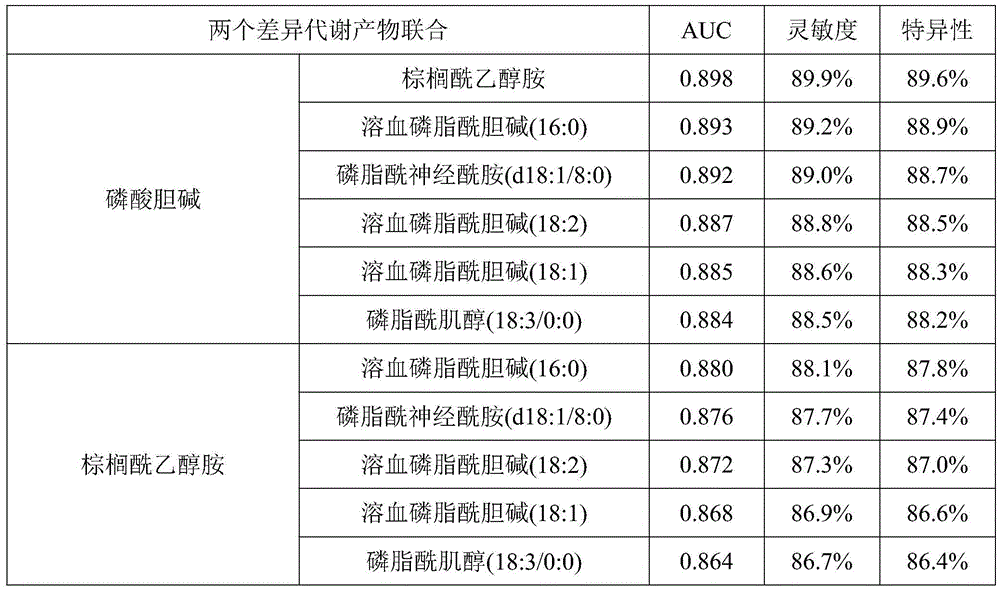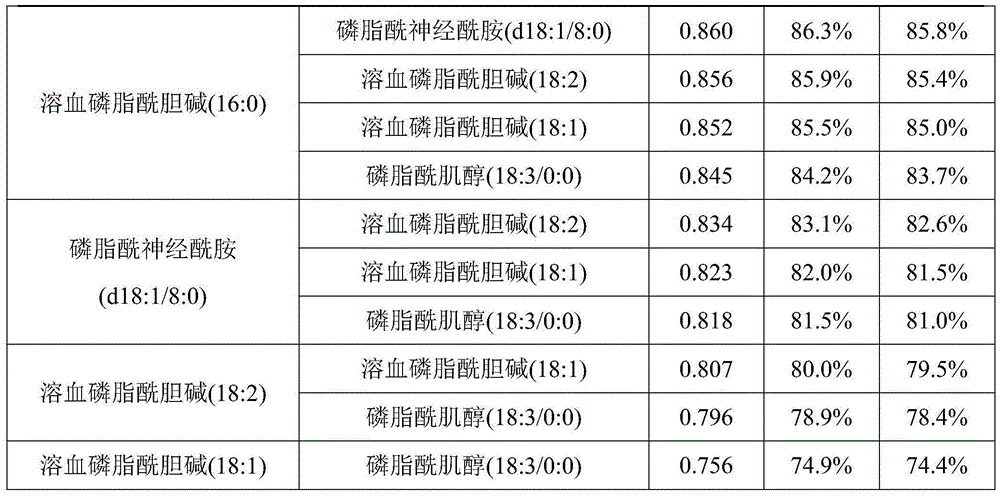Metabolism marker for diagnosis of acute coronary syndrome
A technique for metabolic markers and coronary syndrome, applied in the field of metabolic markers for the diagnosis of acute coronary syndrome, to achieve the effect of promoting standardization, high sensitivity, and improving the convenience of diagnosis
- Summary
- Abstract
- Description
- Claims
- Application Information
AI Technical Summary
Problems solved by technology
Method used
Image
Examples
Embodiment 1
[0031] Example 1: Screening and characterization of plasma differential metabolites between patients with normal coronary arteries and patients with acute coronary syndrome
[0032] 1. Objects and methods
[0033] 1. Source of specimen
[0034] After obtaining the patient’s consent, the peripheral venous blood plasma of 460 patients with acute coronary syndrome and 350 patients with normal coronary arteries were collected from Jiangsu Provincial People’s Hospital from September 2010 to June 2015. All patients or people with normal coronary arteries were treated by coronary artery. Confirmed by angiography. The age and sex of people with normal coronary arteries match those of patients with acute coronary syndrome. All patients with acute coronary syndrome and those with normal coronary arteries have normal heart, lung, liver and kidney and hematopoietic functions.
[0035] The blood collection time was in the early morning on an empty stomach.
[0036] 2. Main reagents
[0037] Aceton...
Embodiment 2
[0058] Example 2: Construction of ROC curve to verify the ability of 7 different metabolites to diagnose acute coronary syndrome
[0059] The receiver operating curve (ROC) method was used for verification, and its ability to diagnose coronary heart disease was judged by the expression levels of differential metabolites in the plasma of patients with acute coronary syndrome and normal coronary arteries. The results showed that phosphocholine, palmitoylethanolamine, lysophosphatidylcholine (16:0), phosphatidylceramide (d18:1 / 8:0), lysophosphatidylcholine (18:2), lysophosphatidylcholine (18:2) The 7 different metabolites of choline (18:1) and phosphatidylinositol (18:3 / 0:0) are used to diagnose and distinguish acute coronary syndrome patients from patients with normal coronary arteries. The ROC curve The area under area (AUC) is greater than 0.7, which is of clinical diagnostic significance; when used in combination for diagnosis, as the number of combinations increases, the AUC fu...
Embodiment 3
[0069] Example 3: Application in screening of drugs for treatment or alleviation of acute coronary syndrome
[0070] The plasma of 190 patients with acute coronary syndrome before and after drug treatment was tested. The results showed that as the course of drug treatment increased, the patient’s condition gradually alleviated. The seven metabolic markers provided by the present invention are in plasma The level gradually tends to the level of healthy people, and there is no significant difference between the plasma levels of healthy people after complete cure (P>0.05). This result is consistent with the detection result of coronary angiography. Therefore, the metabolic markers provided by the present invention can be used to screen drugs for treating or alleviating acute coronary syndrome.
PUM
 Login to View More
Login to View More Abstract
Description
Claims
Application Information
 Login to View More
Login to View More - R&D
- Intellectual Property
- Life Sciences
- Materials
- Tech Scout
- Unparalleled Data Quality
- Higher Quality Content
- 60% Fewer Hallucinations
Browse by: Latest US Patents, China's latest patents, Technical Efficacy Thesaurus, Application Domain, Technology Topic, Popular Technical Reports.
© 2025 PatSnap. All rights reserved.Legal|Privacy policy|Modern Slavery Act Transparency Statement|Sitemap|About US| Contact US: help@patsnap.com


